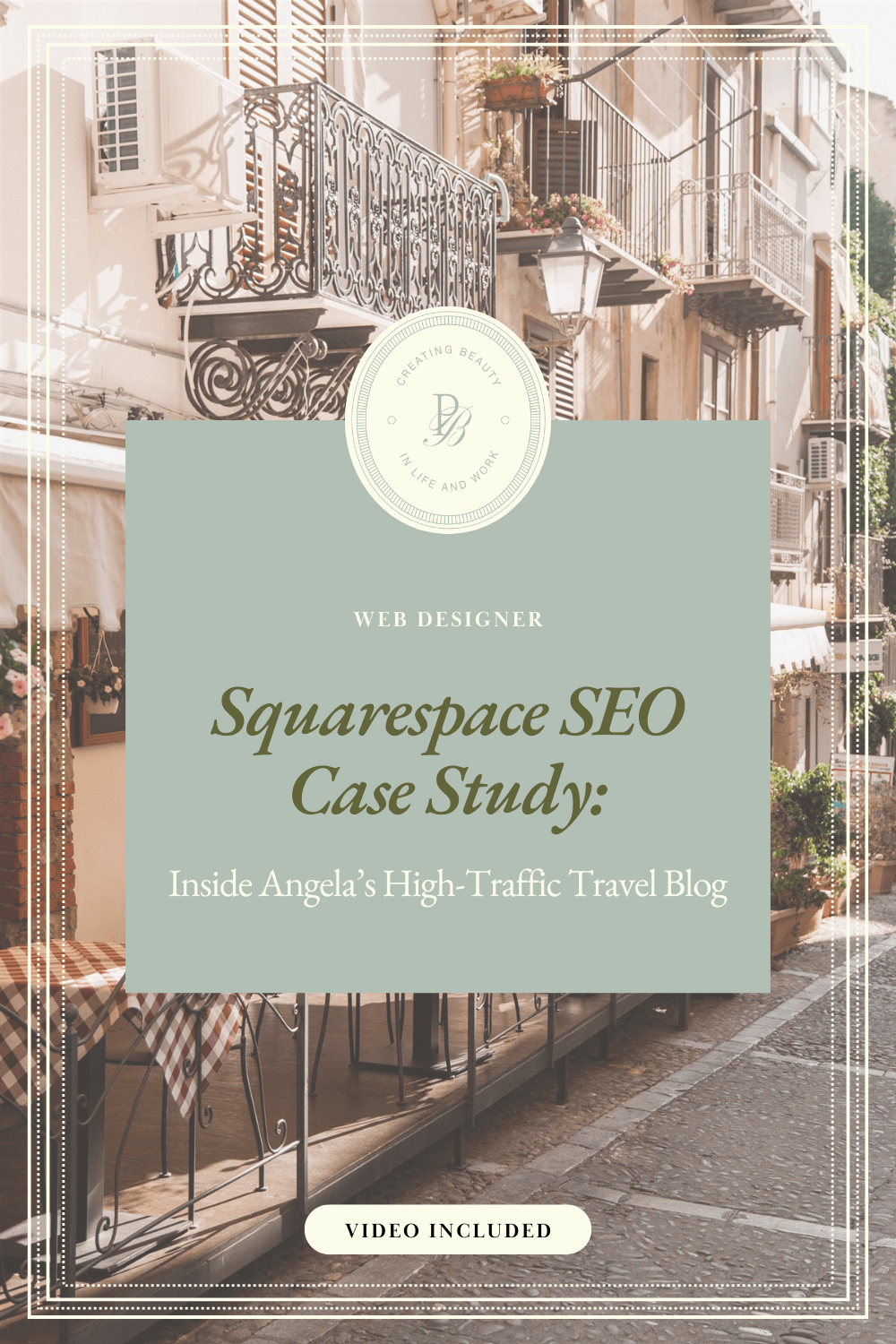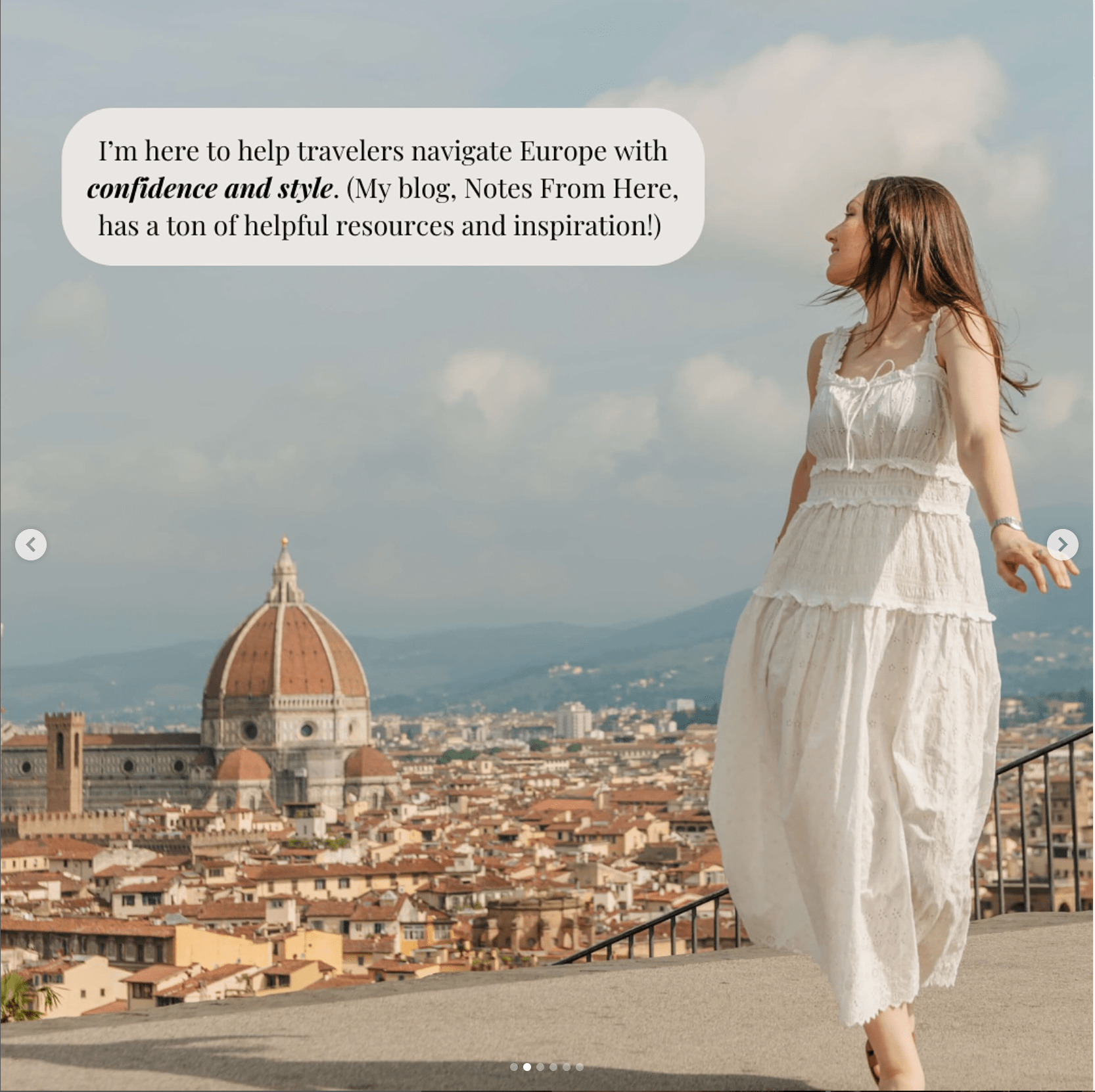Squarespace SEO Case Study: Inside Angela’s High-Traffic Travel Blog
Prefer to watch?
Here’s the video!
Mentioned in the Video:
*Yup - that’s an affiliate link! My margarita fund thanks you kindly!
Rather read all about it?
I hit over 10,000 pageviews with just 64 posts
—because I focused on strategy, not volume.
Would you love for your website traffic to enjoy the hockey stick effect?
You know the one—where your numbers start slow, then suddenly shoot up and up… all from free traffic (hello, Google!).
That’s exactly what happened for past Audience Academy student Angela, who took her blog from zero to 10,000 monthly pageviews by writing about topics she genuinely loves.
Angela’s blog, Notes From Here, is full of curated, thoughtful content for discerning travelers.
From skiing in Europe to luxury shopping city guides, she’s built a site that attracts readers and ranks on Google—without following the cookie-cutter playbook.
In this interview, she’s pulling back the curtain on how she chose her niche, why she stuck with Squarespace, and what’s working for her SEO strategy
(spoiler: one of her top posts came to her in the shower). If you’re dreaming of growing traffic and building a blog you love? This one’s for you.
From Project Manager to Passionate Travel Blogger
Tell us a bit about the business you run—and how you decided to start it.
Angela: I run a travel blog called Notes From Here. It’s Europe-focused, and I started it after years of dabbling with diary-style blogs. I knew I was playing small, and I really wanted to build something more strategic—something that could grow.
I spent a long time figuring out my direction. I considered the business space since I’m a project manager by day, but in the end, I thought, what do I already talk about all the time? And the answer was… Europe.
My friends were constantly asking me for travel advice. But not just “where should I go?” More like:
“Is this Delta route from New York to Milan better than flying through London?”
“Where’s the actually good burger near this fancy hotel?”
I realized there was a gap between the aspirational Instagram travel posts and the “here’s how to travel for free by putting everything on credit cards” blogs.
What about the people who like nice things, are willing to spend money, but want real, smart recommendations?
That’s who I write for. I call it discerning travel—not budget, not luxury… just thoughtful and intentional.
Getting the Blog Started
How did you realize a travel blog could be more than just a hobby?
Angela: Full disclosure—I’m still working full-time. I’m a project manager in a big company, managing teams across Europe. So the blog is part-time for now, but the goal is to grow it into something full-time.
What really pushed me to take it seriously was corporate burnout. I had so many ideas at work that went nowhere. With the blog, if I think something has value—I can just try it. I can test and learn without waiting for anyone’s approval. It’s empowering.
Squarespace vs. WordPress
You chose to build your blog on Squarespace, even though most travel bloggers recommend WordPress. Why?
Angela: I’ve actually used Squarespace since way back—like, 2007-ish. I loved how easy it was and how professional it made my writing look. Over the years, I’ve blogged on different platforms, but I always came back to Squarespace.
When I got serious about turning this into a business, I had to make the big decision: Do I rebuild everything in WordPress, or do I stick with Squarespace?
Here’s what tipped the scales for me:
I already had a site on Squarespace 7.0 and wanted to upgrade it for SEO and monetization.
I loved the sleek, clean feel of Squarespace sites.
I worried about WordPress having too much freedom. Without clear guardrails, I knew I could spend months tweaking instead of writing.
And here’s something else: there’s this conversation happening in the travel blogging world right now—about how a lot of WordPress sites look identical. With Google’s new helpful content updates, that could actually hurt your rankings.
You Can Rank on Google with Squarespace
So many people think Squarespace can’t rank on Google. Have you found that to be true?
Angela: Not at all. I’ve been able to:
Rank blog posts on page 1 of Google—some are even in the #1 spot.
Keep up with (or surpass!) similar blogs that are built on WordPress.
Drive consistent, growing traffic with SEO alone.
I think some of the concerns around Squarespace—like page speed—can be distractions. Sure, certain testers might flag things, but real-world performance? Mine’s great.
And here’s the fun part:
One of my best-performing blog posts was literally an idea I had in the shower.
It’s short, super keyword-targeted, and focused on a very popular European destination.
It’s not a 2,000-word beast—but it gets tons of clicks because it’s relevant and direct.
Once that post hit #1 on Google, it was like, whoa. I check my Squarespace analytics like it’s a game. “Ooh! Someone from Sri Lanka is reading right now!”
It’s addictive in the best way—and proof that Squarespace can hold its own when it comes to SEO.
"I used to be afraid of starting a blog because I thought I’d have to ‘feed the blog forever.’
But now? SEO feels like a puzzle I actually love solving."
From Zero to 10,000+ Monthly Views—Without 100 Posts
You mentioned some blog posts have really taken off. Where are you at now in terms of traffic?
Angela: So last month I passed 10,000 pageviews—which felt huge! And here’s the interesting part: I only have around 64 blog posts.
I’ve seen a lot of bloggers say they didn’t hit that milestone until they had 100+ posts, so I feel like I’m getting more mileage out of each piece.
What’s helped:
Focusing on quality over quantity
Being super intentional about SEO and keyword targeting
Planning my content around high-impact topics
I used to be afraid of starting a blog because I thought, “I’ll have to feed the blog forever.” But now I see SEO as a puzzle. You find high-opportunity keywords, write the post, and check a few months later: did it work?
And more often than not… it does.
Why Angela Joined Audience Academy
You joined Audience Academy. What made you feel like you needed a course to teach you content strategy?
Angela: There were a few reasons.
I was running into Squarespace quirks—like how my domain name is different from my blog name—and I wasn’t sure how to make it look and feel like a real blog.
Everyone around me was using WordPress, and I was second-guessing everything.
I found your tutorials and started thinking, okay, this woman knows how to blog well on Squarespace.
Then I read more about Audience Academy and realized—it wasn’t just about design. It was about strategy. About building an audience. And that’s what I truly wanted.
It wasn’t just about making a site pretty. I wanted to:
Learn how to set up an email list
Grow an audience that actually reads and trusts me
Create a blog that’s both helpful and profitable
So it ended up being a no-brainer.
What lessons or takeaways from the course have made the biggest difference for you?
Angela: SO many.
One big one was this annoying issue I had with my blog header—I couldn’t figure out how to get the title of my blog to show up properly on the page. Then I saw your Canva template for blog headers and was like, ohhhhhh. Problem solved in two seconds.
Another huge win: your email welcome sequence template.
I’m not shy, but for some reason writing that sequence gave me serious mental roadblocks. Your step-by-step structure took away the overwhelm and helped me write something I was actually proud of.
I even reread it weeks later while riding a train and thought, “This is good.” That’s when I knew I’d really gotten value from the course.
Not All Content Needs to Be“Blog-Perfect”
Your blog is filled with super helpful, unique content. What are your favorite types of posts to write?
Angela: I love writing from my personal experience—and from a strategic lens. Some of my favorite content leans into my background:
I used to work for Cartier in NYC and Louis Vuitton during grad school, so I have a deep love for luxury shopping.
One of my top-performing posts is about how to luxury shop in Europe—how to research boutiques, what to expect, what’s worth it.
It might not be the most Pinterest-y content, but it performs really well. Not a lot of people are writing about that with real-world experience behind it.
I also organize content around what I call passion pillars:
Art & history
Food & wine
Beach & nature
And beyond the dreamy stuff, I also write really practical content—like an explainer post on the new UK travel form. That post got picked up by Google Discover and brought in 1,000 views in two days.
There were no affiliate links. It wasn’t a sexy post. But it was helpful.
That’s what I love—writing posts that feel like I’m talking to a smart friend who wants to be in-the-know.
"I wrote most of my top-performing posts based on trips I took years ago
—with imperfect photos and zero pressure to be ‘blog-ready.’”
You Don’t Need a Brand-New Trip to Write a Great Blog Post
Are you creating content from new trips, or writing from past ones?
Angela: Oh, I definitely write from past trips. Some are from three years ago!
It’s a bit tricky, because past-me didn’t have a blog. Past-me had an iPhone and bad lighting. But I remind myself:
The experience is still valid.
The content is still useful.
The photos don’t have to be perfect.
Of course, blogging has changed how I travel. I’m headed to Porto soon, and this time I’m packing a shot list. But the truth is: you can 100% write from your backlog. You don’t need to be a full-time traveler.
And for SEO, that might even be better.
The Keyword Research Process
Let’s talk SEO. What’s your process for choosing blog post topics?
Angela: First of all, I used to watch a million YouTube videos on this—and they all used the most boring examples like “wet cat food vs dry cat food.” Not helpful.
Here’s how I think about it now:
SEO is just the math behind how people say things.
Example:
“Where to stay in Paris” and “Best Paris hotels” are two ways of saying the same thing.
But mathematically, one of those gets way more searches than the other.
So my goal is to figure out how people actually phrase the thing they’re searching for.
I use Keysearch, and one tip I love is using the “Organic Keyword Checker.” You can drop a competitor’s URL in there and see exactly what keywords that post is ranking for. It’s a goldmine.
And once you’ve found a great keyword? Build around it.
The Secret to Long-Term SEO
You mentioned something really smart: not just posting once about a topic. Can you share more?
Angela: A big mistake I see in travel blogging is what I call “hit it and quit it” content.
People write one post about Paris, never write about it again, and expect to rank.
Google sees your content as a web. The more interlinked, related posts you have on a topic, the more authority you build.
Example: I had one post about skiing in Cortina d’Ampezzo. Inside that post, there was a little section about après-ski. I turned that section into its own post. That new post now ranks in my top 10.
Now I’m building a mini content hub on:
How to ski in Cortina
Where to go for après
Shopping and hotel guides for that area
That’s how you build SEO momentum—not with one big post, but with a layered content strategy.
How to Grow Your Email List Organically
Let’s talk email lists. You started from zero—how did you begin growing it?
Angela: Yep, I started from scratch. My first opt-in was this big, 10-page PDF guide—very detailed, very cerebral. It was written more for the seasoned traveler, which is part of my audience, but I realized later I also needed to serve people going to Europe for the first time.
What helped me get started:
I created a landing page with strong sales copy, even before my opt-in was finished.
I used that landing page to start collecting emails—even when my list was literally zero.
Writing the sales copy before the opt-in actually helped shape the resource itself.
My second opt-in came from a high-performing blog post about luxury shopping in Europe. The post was super long (like, 3,000 words), so I created a soft email gate: to read the second half, readers had to sign up. It worked really well.
I’ve also added more traditional travel blogger-style opt-ins:
Packing lists
Destination-specific freebies
PDF versions of blog posts (coming soon!)
And I’ve been testing what works:
Landing pages convert at around 20%
Inline forms convert around 5–10%
Pop-ups vary, but relevance is everything
Oh—and your summary block hack was a game-changer. Now I can update opt-ins across my site in one click, instead of editing a hundred blog posts. Total lifesaver.
How to Keep Your List Engaged (Without Weekly Emails)
Now that you’ve got subscribers, what’s your strategy for emailing them?
Angela: First, shoutout to the Audience Academy welcome sequence. That became my whole foundation. It helped me figure out what kind of content belonged in email versus on the blog.
Here’s what works for me:
Email every other week. Weekly felt overwhelming, and I knew I wouldn’t stick to it. Every other week is sustainable—for me and my audience.
The goal of each email is to lead readers back to the blog—usually through a story or timely topic that connects with a post.
I use a spreadsheet to map out emails in advance, based on what’s happening in the world (like tax season, travel restrictions, or even upcoming holidays).
Example: I’m writing about tax season for expats right now, and I’ll link it to a post I wrote about money and travel. It’s all about finding real-world moments and tying them back to your content.
And honestly? Open rates are around 60%. Click rates are 20%. People are reading and engaging. That’s what matters.
The Secret to Successful Blogs
"You don’t even need to be good—you just need to be consistent.
That’s the superpower most people overlook."
What would you say to someone starting from zero—who’s overwhelmed by the idea of staying consistent?
Angela: Oh, I felt that way too.
In the beginning, I would go through big cycles. I’d write five posts in a week, burn out, then disappear for a month. It was stressful and unsustainable.
What Audience Academy helped me realize is that:
You don’t have to be perfect.
You don’t even have to be great.
You just have to be consistent.
The real superpower in this space? Showing up. Doing the work. Hitting publish—again and again.
Now, I post regularly and send two emails a month. And guess what? My list is growing, my traffic is growing, and I’ve hit those 10,000 pageviews way faster than I expected.
Why Audience Academy Was Worth Every Penny
For someone on the fence about joining Audience Academy—what would you say?
Angela: I totally get the hesitation. It’s easy to think, “I can get all this for free on YouTube.” And honestly, I’ve taken courses before that didn’t offer anything new.
But Audience Academy is different.
You’re not just watching videos—you’re following a proven method that works.
You’re learning from someone who’s actually done it, and done it well.
You have templates, systems, and strategy that cut out all the second-guessing.
The moment I joined, I felt committed. I invested. And I showed up.
That hockey-stick chart you show in the training? That’s exactly what happened for me. I can literally see the shape of my growth in Google Analytics. It’s real.
Ready to See the Same Kind of Growth?
Angela’s story is proof that you don’t need to blog every day, travel constantly, or be a tech genius to grow a real audience. You do need strategy, consistency, and a willingness to start where you are.
If you’d like to grow your own traffic snowball and write content that gets found, check out the Free Content Creation Outlines for Surefire, Profitable Posts.
And if you’re ready to go deeper, don’t miss Audience Academy. It’s the exact framework Angela used to build traffic, grow her list, and start turning her blog into a business—while working full-time.
✨ And of course, go binge Angela’s blog Notes From Here—especially her amazing guide to learning to ski in Europe. It’s full of tips, insider info, and gorgeous destination ideas for your next trip.











